JEEP GRAND CHEROKEE 2013 WK2 / 4.G SRT Owners Manual
Manufacturer: JEEP, Model Year: 2013, Model line: GRAND CHEROKEE, Model: JEEP GRAND CHEROKEE 2013 WK2 / 4.GPages: 661, PDF Size: 4.79 MB
Page 241 of 661
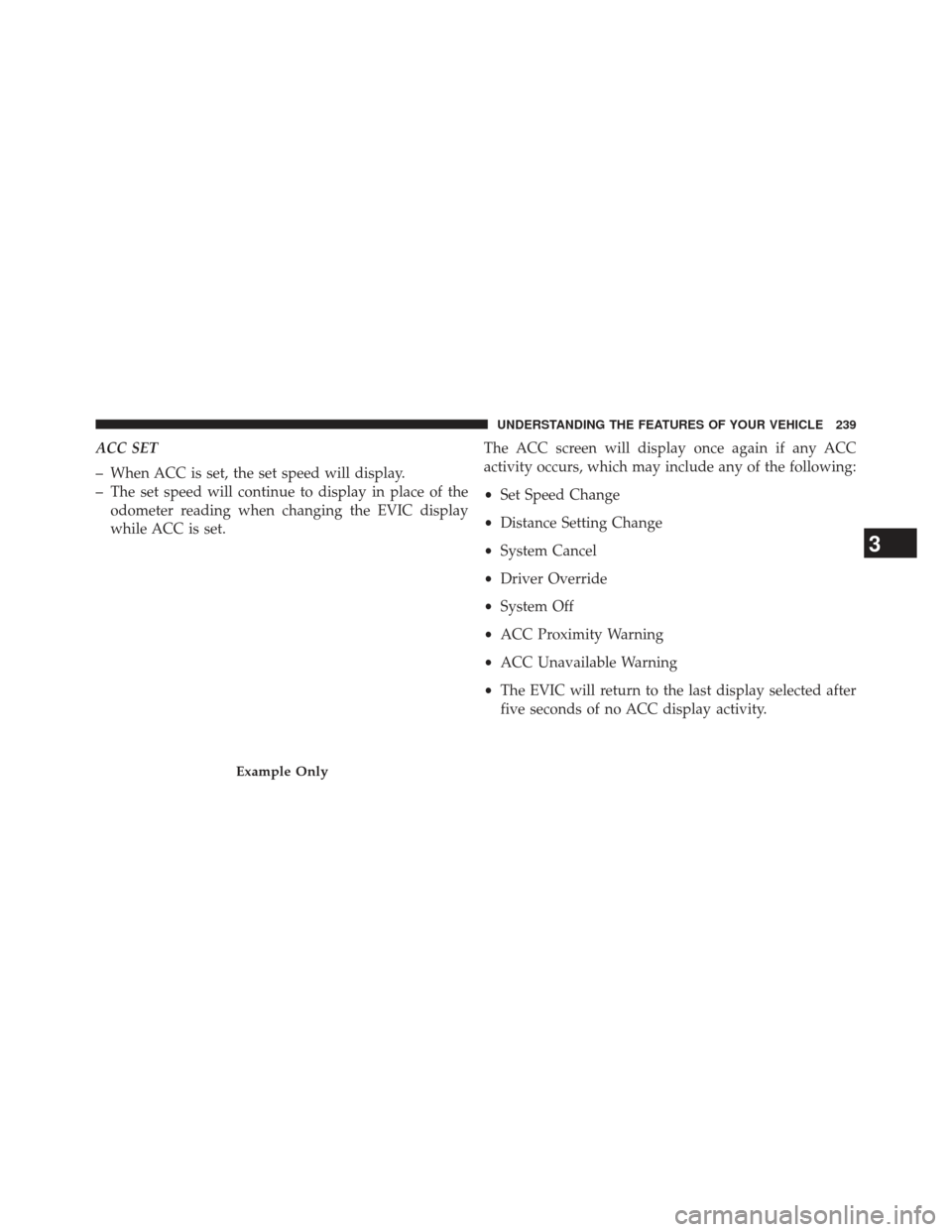
ACC SET
– When ACC is set, the set speed will display.
– The set speed will continue to display in place of theodometer reading when changing the EVIC display
while ACC is set. The ACC screen will display once again if any ACC
activity occurs, which may include any of the following:
•
Set Speed Change
• Distance Setting Change
• System Cancel
• Driver Override
• System Off
• ACC Proximity Warning
• ACC Unavailable Warning
• The EVIC will return to the last display selected after
five seconds of no ACC display activity.
Example Only
3
UNDERSTANDING THE FEATURES OF YOUR VEHICLE 239
Page 242 of 661
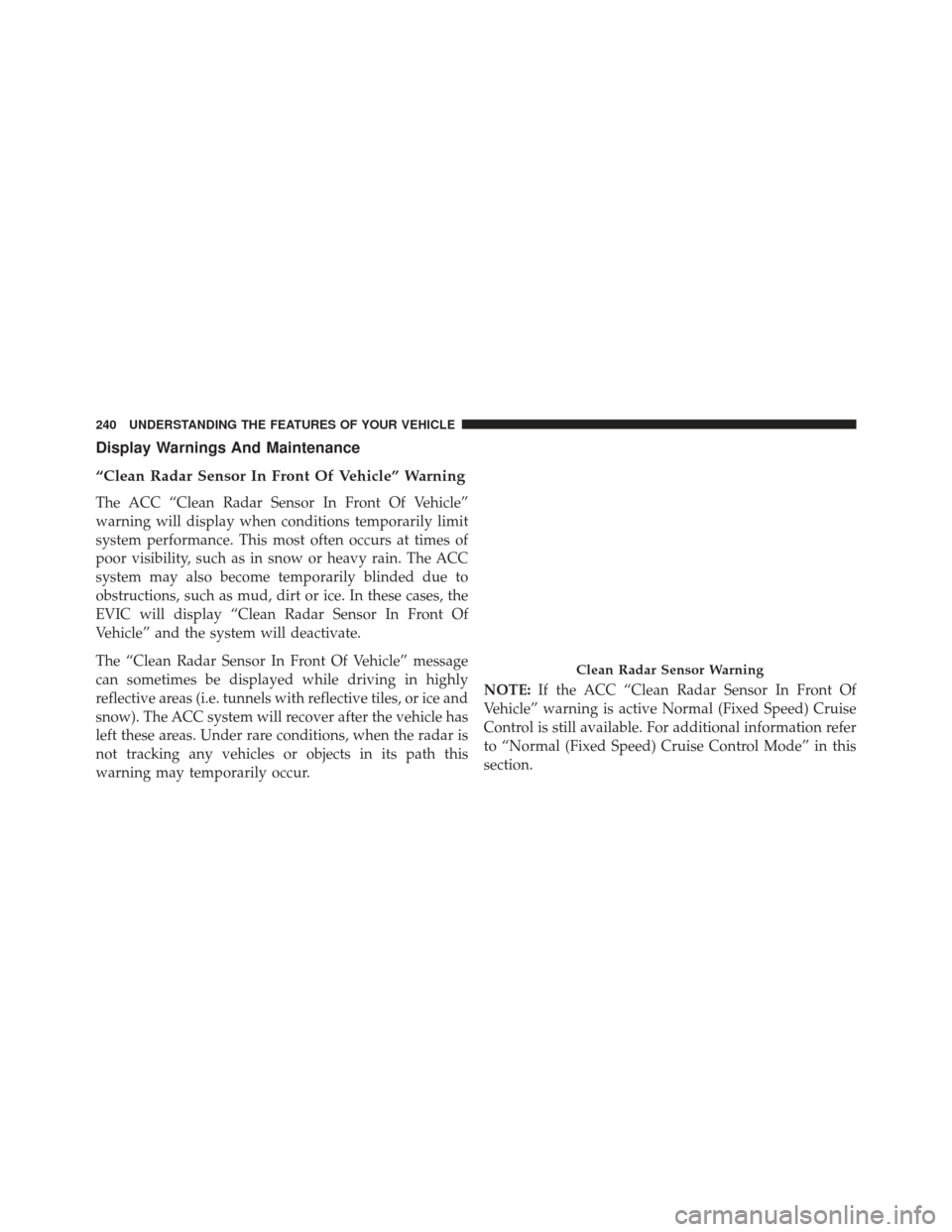
Display Warnings And Maintenance
“Clean Radar Sensor In Front Of Vehicle” Warning
The ACC “Clean Radar Sensor In Front Of Vehicle”
warning will display when conditions temporarily limit
system performance. This most often occurs at times of
poor visibility, such as in snow or heavy rain. The ACC
system may also become temporarily blinded due to
obstructions, such as mud, dirt or ice. In these cases, the
EVIC will display “Clean Radar Sensor In Front Of
Vehicle” and the system will deactivate.
The “Clean Radar Sensor In Front Of Vehicle” message
can sometimes be displayed while driving in highly
reflective areas (i.e. tunnels with reflective tiles, or ice and
snow). The ACC system will recover after the vehicle has
left these areas. Under rare conditions, when the radar is
not tracking any vehicles or objects in its path this
warning may temporarily occur.NOTE:
If the ACC “Clean Radar Sensor In Front Of
Vehicle” warning is active Normal (Fixed Speed) Cruise
Control is still available. For additional information refer
to “Normal (Fixed Speed) Cruise Control Mode” in this
section.
Clean Radar Sensor Warning
240 UNDERSTANDING THE FEATURES OF YOUR VEHICLE
Page 243 of 661
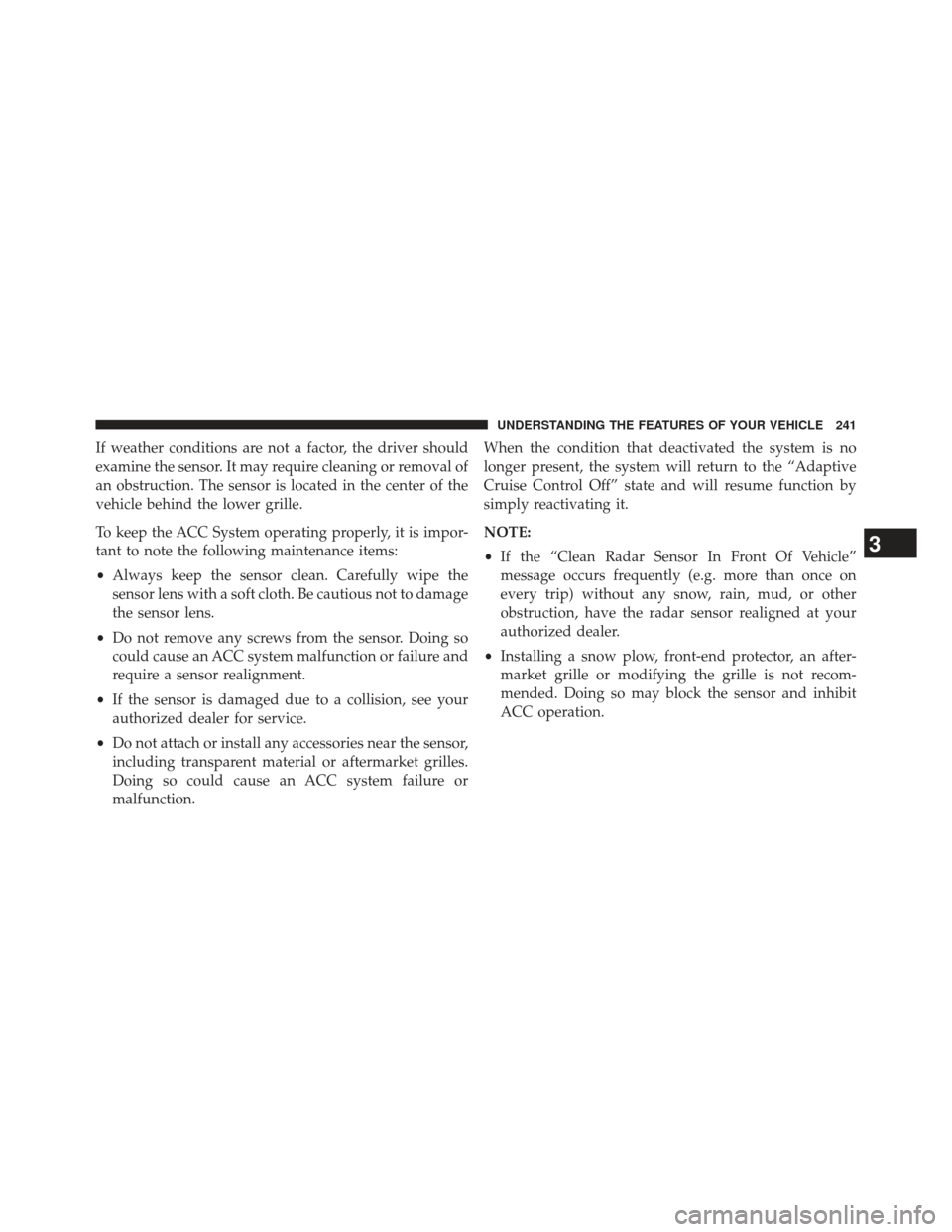
If weather conditions are not a factor, the driver should
examine the sensor. It may require cleaning or removal of
an obstruction. The sensor is located in the center of the
vehicle behind the lower grille.
To keep the ACC System operating properly, it is impor-
tant to note the following maintenance items:
•Always keep the sensor clean. Carefully wipe the
sensor lens with a soft cloth. Be cautious not to damage
the sensor lens.
• Do not remove any screws from the sensor. Doing so
could cause an ACC system malfunction or failure and
require a sensor realignment.
• If the sensor is damaged due to a collision, see your
authorized dealer for service.
• Do not attach or install any accessories near the sensor,
including transparent material or aftermarket grilles.
Doing so could cause an ACC system failure or
malfunction. When the condition that deactivated the system is no
longer present, the system will return to the “Adaptive
Cruise Control Off” state and will resume function by
simply reactivating it.
NOTE:
•
If the “Clean Radar Sensor In Front Of Vehicle”
message occurs frequently (e.g. more than once on
every trip) without any snow, rain, mud, or other
obstruction, have the radar sensor realigned at your
authorized dealer.
• Installing a snow plow, front-end protector, an after-
market grille or modifying the grille is not recom-
mended. Doing so may block the sensor and inhibit
ACC operation.
3
UNDERSTANDING THE FEATURES OF YOUR VEHICLE 241
Page 244 of 661
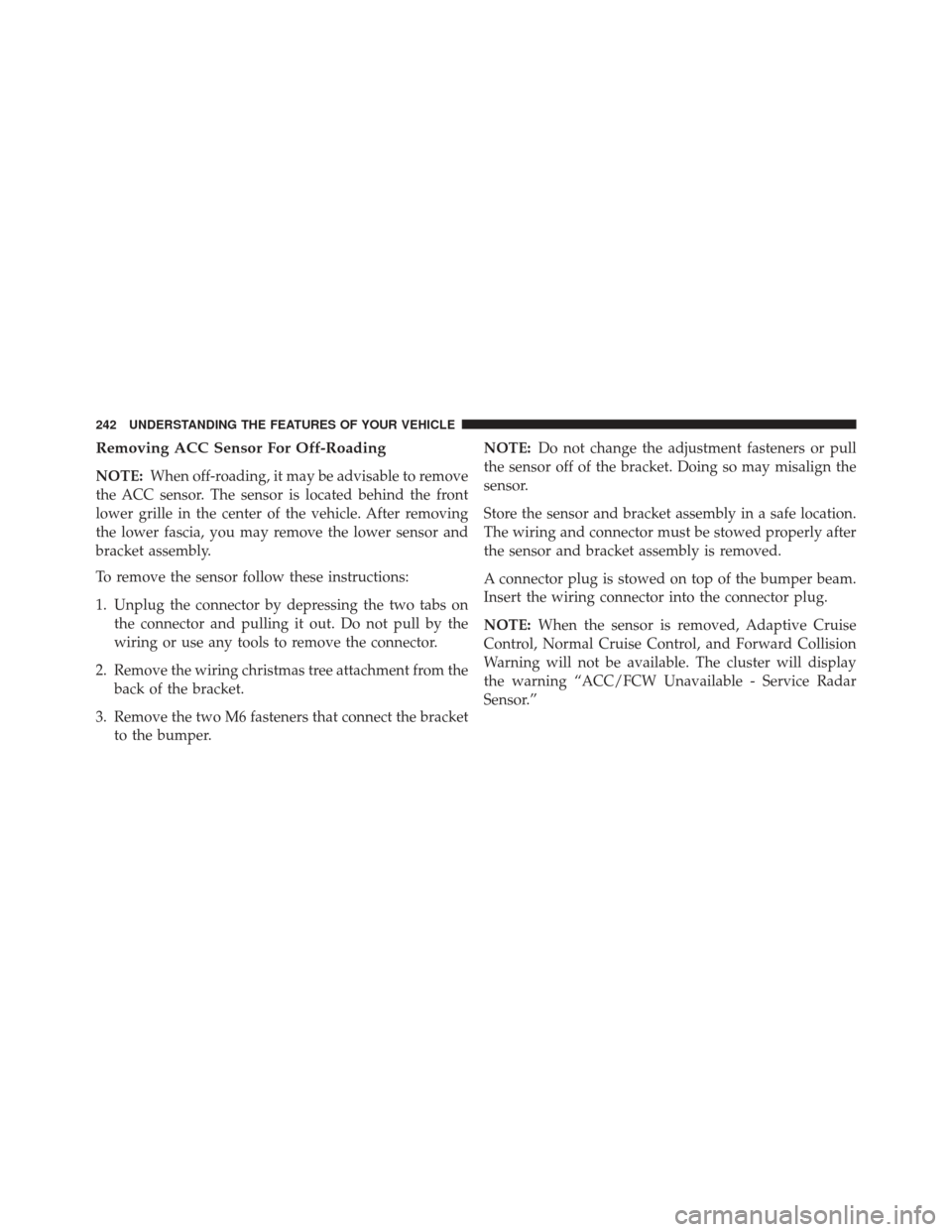
Removing ACC Sensor For Off-Roading
NOTE:When off-roading, it may be advisable to remove
the ACC sensor. The sensor is located behind the front
lower grille in the center of the vehicle. After removing
the lower fascia, you may remove the lower sensor and
bracket assembly.
To remove the sensor follow these instructions:
1. Unplug the connector by depressing the two tabs on the connector and pulling it out. Do not pull by the
wiring or use any tools to remove the connector.
2. Remove the wiring christmas tree attachment from the back of the bracket.
3. Remove the two M6 fasteners that connect the bracket to the bumper. NOTE:
Do not change the adjustment fasteners or pull
the sensor off of the bracket. Doing so may misalign the
sensor.
Store the sensor and bracket assembly in a safe location.
The wiring and connector must be stowed properly after
the sensor and bracket assembly is removed.
A connector plug is stowed on top of the bumper beam.
Insert the wiring connector into the connector plug.
NOTE: When the sensor is removed, Adaptive Cruise
Control, Normal Cruise Control, and Forward Collision
Warning will not be available. The cluster will display
the warning “ACC/FCW Unavailable - Service Radar
Sensor.”
242 UNDERSTANDING THE FEATURES OF YOUR VEHICLE
Page 245 of 661
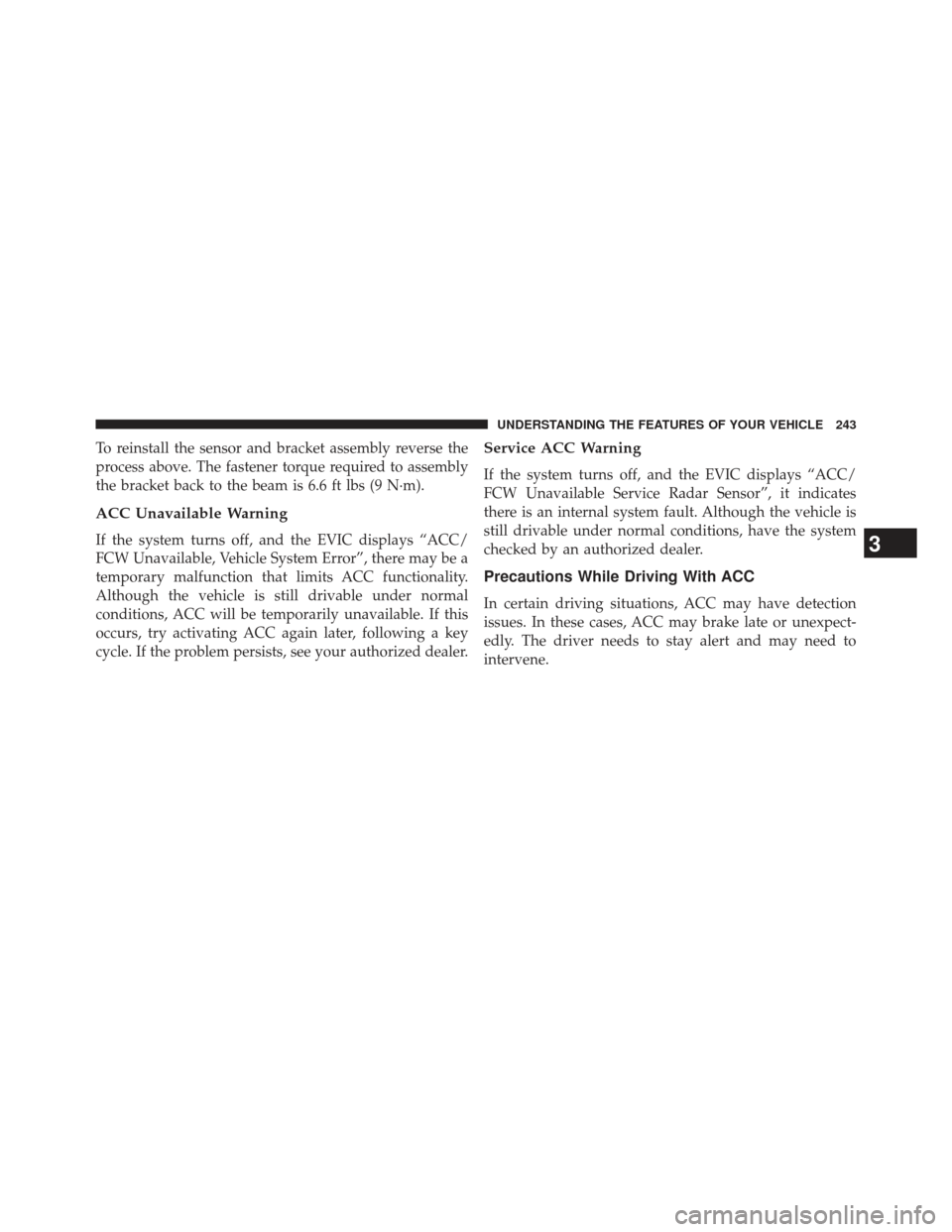
To reinstall the sensor and bracket assembly reverse the
process above. The fastener torque required to assembly
the bracket back to the beam is 6.6 ft lbs (9 N·m).
ACC Unavailable Warning
If the system turns off, and the EVIC displays “ACC/
FCW Unavailable, Vehicle System Error”, there may be a
temporary malfunction that limits ACC functionality.
Although the vehicle is still drivable under normal
conditions, ACC will be temporarily unavailable. If this
occurs, try activating ACC again later, following a key
cycle. If the problem persists, see your authorized dealer.
Service ACC Warning
If the system turns off, and the EVIC displays “ACC/
FCW Unavailable Service Radar Sensor”, it indicates
there is an internal system fault. Although the vehicle is
still drivable under normal conditions, have the system
checked by an authorized dealer.
Precautions While Driving With ACC
In certain driving situations, ACC may have detection
issues. In these cases, ACC may brake late or unexpect-
edly. The driver needs to stay alert and may need to
intervene.
3
UNDERSTANDING THE FEATURES OF YOUR VEHICLE 243
Page 246 of 661
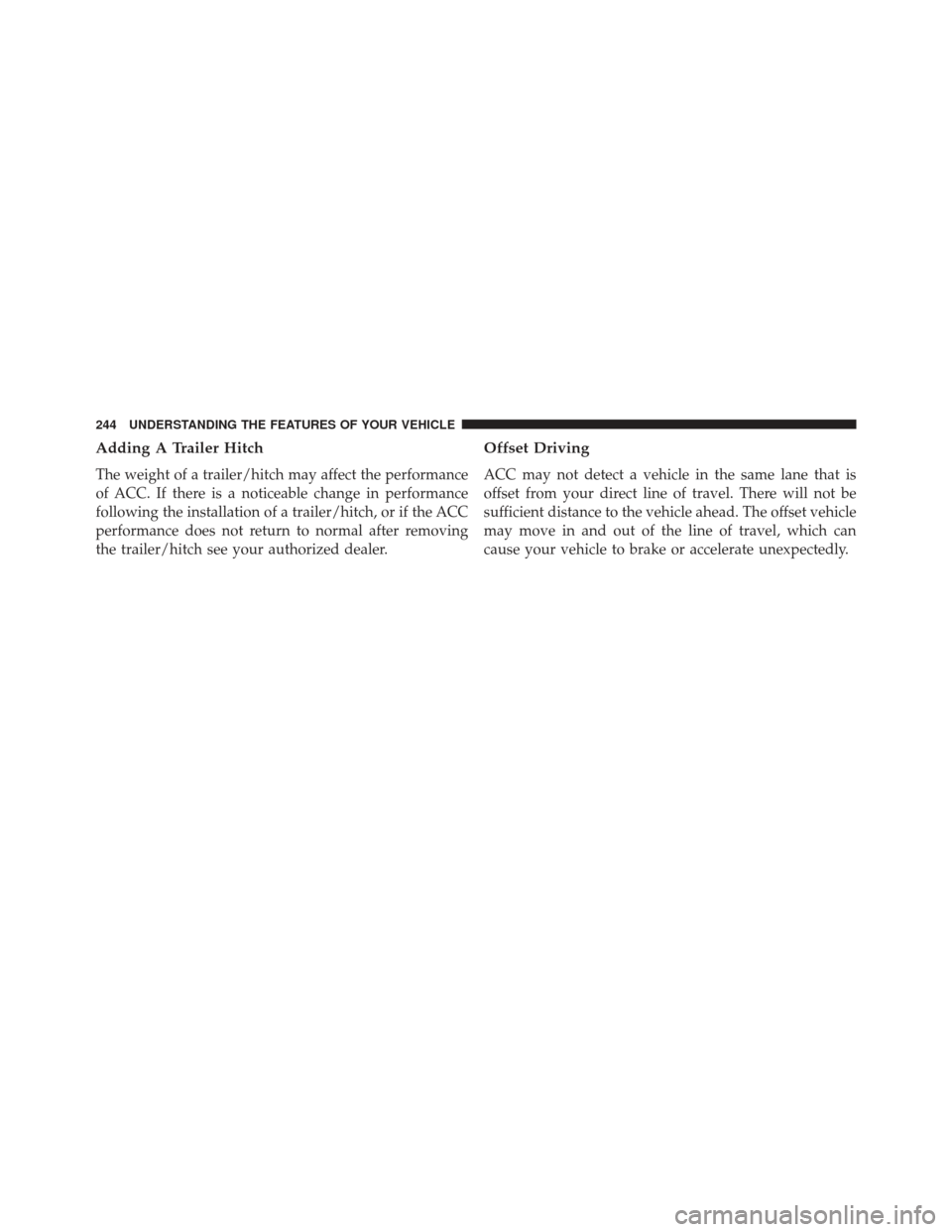
Adding A Trailer Hitch
The weight of a trailer/hitch may affect the performance
of ACC. If there is a noticeable change in performance
following the installation of a trailer/hitch, or if the ACC
performance does not return to normal after removing
the trailer/hitch see your authorized dealer.
Offset Driving
ACC may not detect a vehicle in the same lane that is
offset from your direct line of travel. There will not be
sufficient distance to the vehicle ahead. The offset vehicle
may move in and out of the line of travel, which can
cause your vehicle to brake or accelerate unexpectedly.
244 UNDERSTANDING THE FEATURES OF YOUR VEHICLE
Page 247 of 661
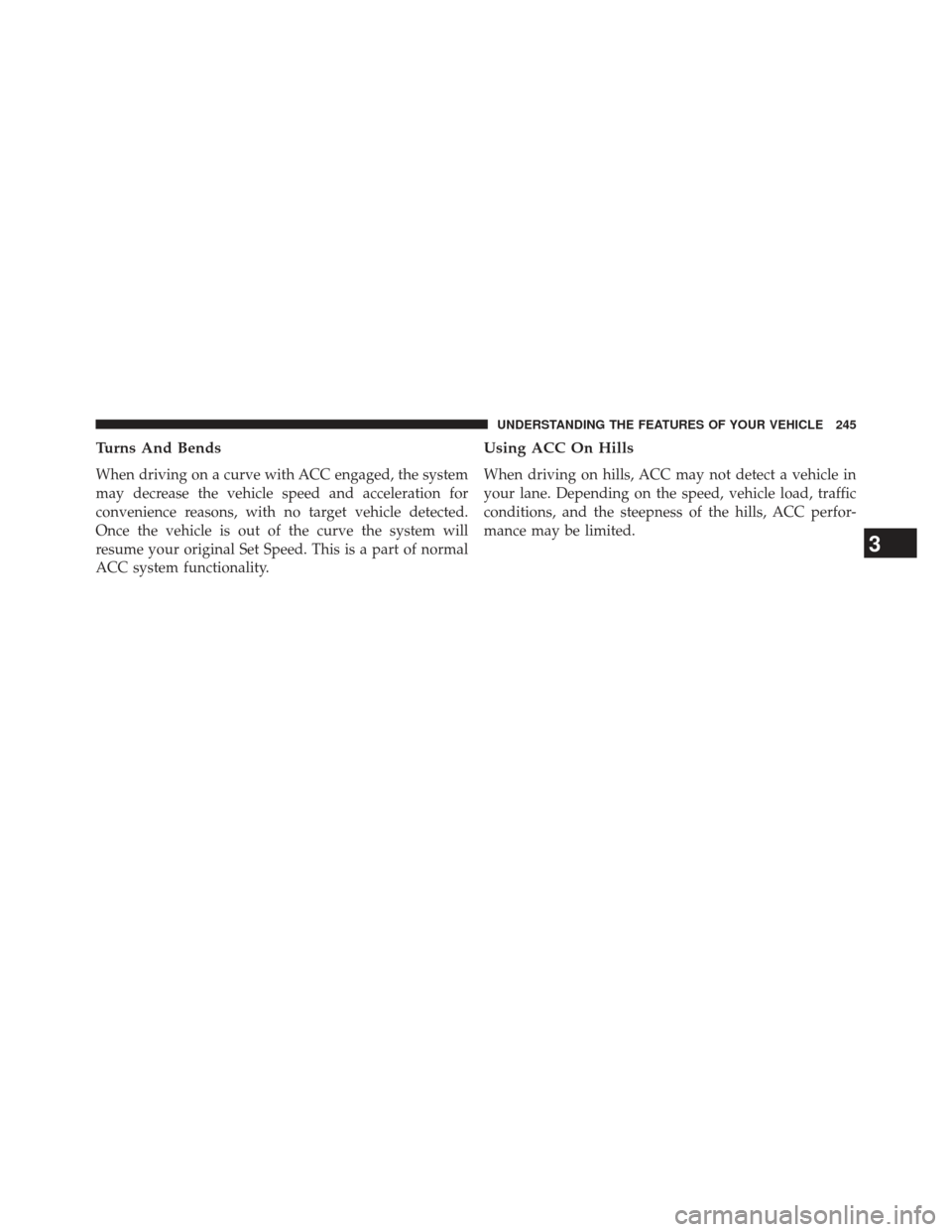
Turns And Bends
When driving on a curve with ACC engaged, the system
may decrease the vehicle speed and acceleration for
convenience reasons, with no target vehicle detected.
Once the vehicle is out of the curve the system will
resume your original Set Speed. This is a part of normal
ACC system functionality.
Using ACC On Hills
When driving on hills, ACC may not detect a vehicle in
your lane. Depending on the speed, vehicle load, traffic
conditions, and the steepness of the hills, ACC perfor-
mance may be limited.
3
UNDERSTANDING THE FEATURES OF YOUR VEHICLE 245
Page 248 of 661
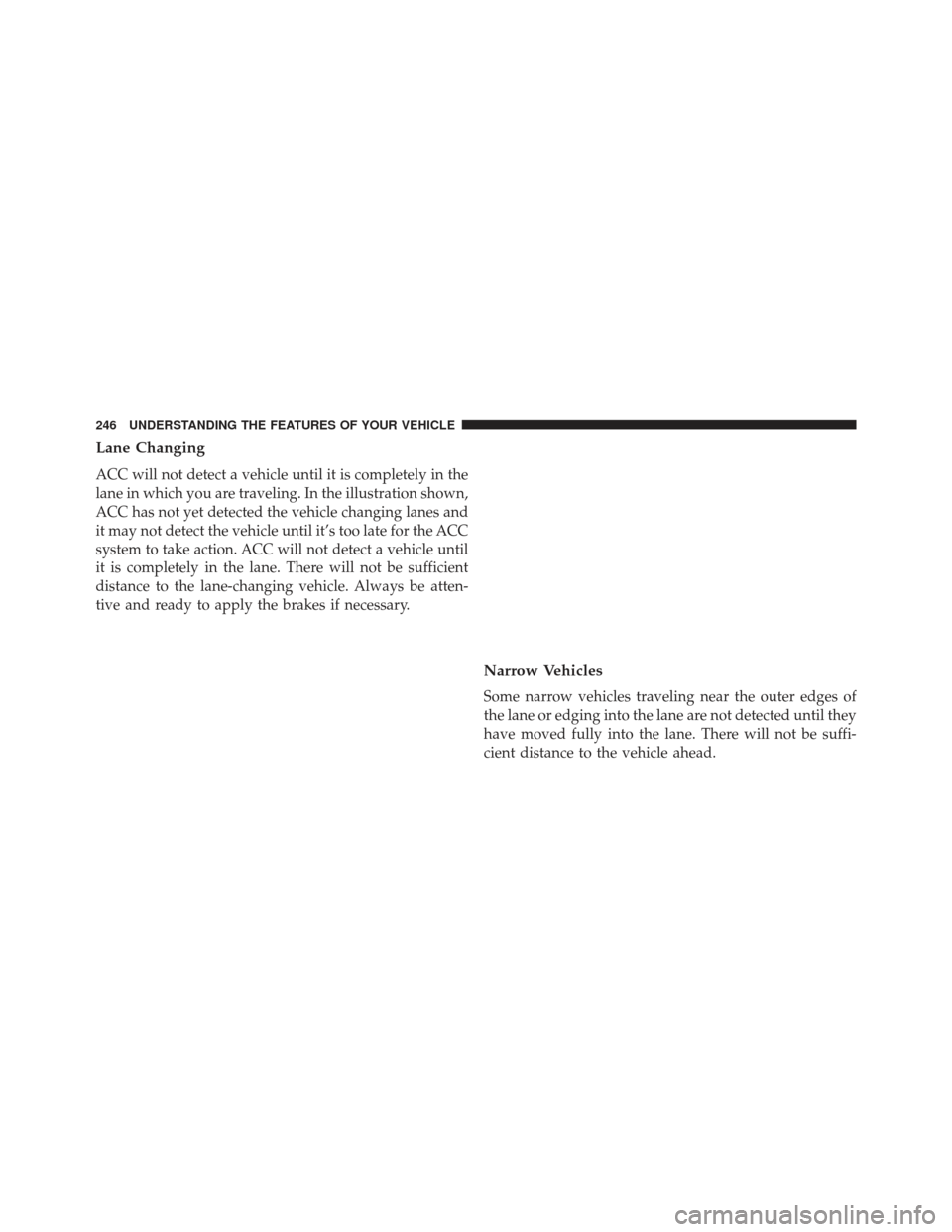
Lane Changing
ACC will not detect a vehicle until it is completely in the
lane in which you are traveling. In the illustration shown,
ACC has not yet detected the vehicle changing lanes and
it may not detect the vehicle until it’s too late for the ACC
system to take action. ACC will not detect a vehicle until
it is completely in the lane. There will not be sufficient
distance to the lane-changing vehicle. Always be atten-
tive and ready to apply the brakes if necessary.
Narrow Vehicles
Some narrow vehicles traveling near the outer edges of
the lane or edging into the lane are not detected until they
have moved fully into the lane. There will not be suffi-
cient distance to the vehicle ahead.
246 UNDERSTANDING THE FEATURES OF YOUR VEHICLE
Page 249 of 661
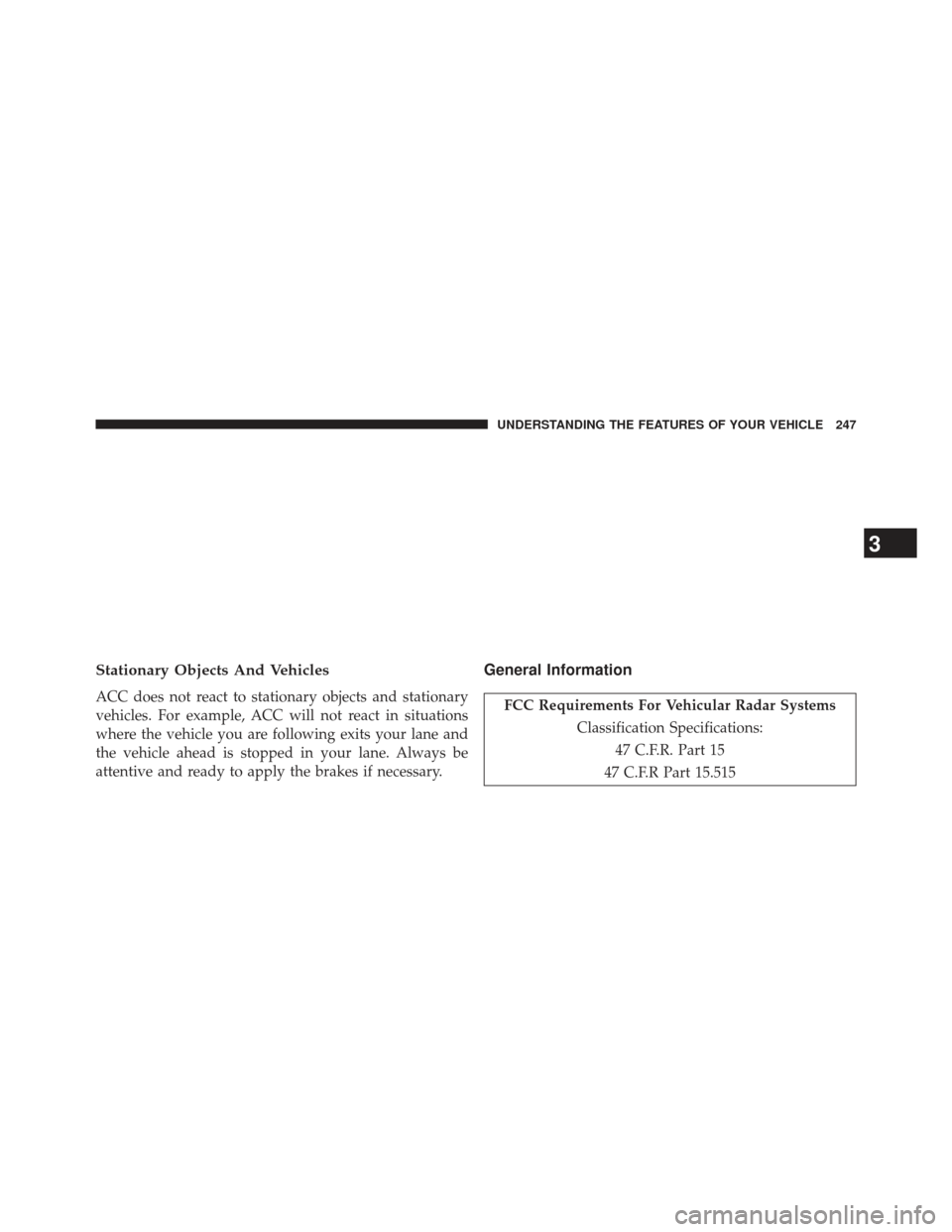
Stationary Objects And Vehicles
ACC does not react to stationary objects and stationary
vehicles. For example, ACC will not react in situations
where the vehicle you are following exits your lane and
the vehicle ahead is stopped in your lane. Always be
attentive and ready to apply the brakes if necessary.
General Information
FCC Requirements For Vehicular Radar SystemsClassification Specifications:47 C.F.R. Part 15
47 C.F.R Part 15.515
3
UNDERSTANDING THE FEATURES OF YOUR VEHICLE 247
Page 250 of 661
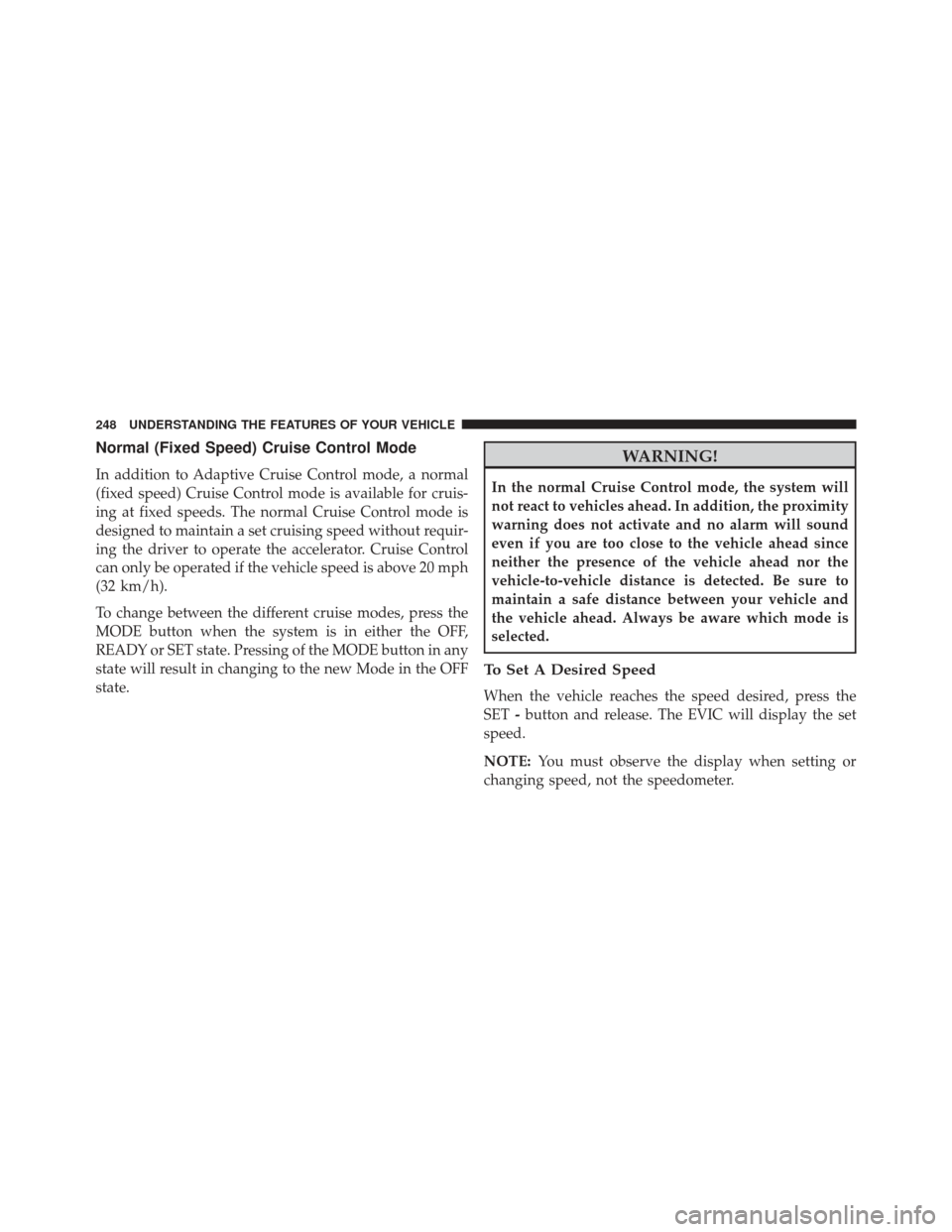
Normal (Fixed Speed) Cruise Control Mode
In addition to Adaptive Cruise Control mode, a normal
(fixed speed) Cruise Control mode is available for cruis-
ing at fixed speeds. The normal Cruise Control mode is
designed to maintain a set cruising speed without requir-
ing the driver to operate the accelerator. Cruise Control
can only be operated if the vehicle speed is above 20 mph
(32 km/h).
To change between the different cruise modes, press the
MODE button when the system is in either the OFF,
READY or SET state. Pressing of the MODE button in any
state will result in changing to the new Mode in the OFF
state.
WARNING!
In the normal Cruise Control mode, the system will
not react to vehicles ahead. In addition, the proximity
warning does not activate and no alarm will sound
even if you are too close to the vehicle ahead since
neither the presence of the vehicle ahead nor the
vehicle-to-vehicle distance is detected. Be sure to
maintain a safe distance between your vehicle and
the vehicle ahead. Always be aware which mode is
selected.
To Set A Desired Speed
When the vehicle reaches the speed desired, press the
SET-button and release. The EVIC will display the set
speed.
NOTE: You must observe the display when setting or
changing speed, not the speedometer.
248 UNDERSTANDING THE FEATURES OF YOUR VEHICLE